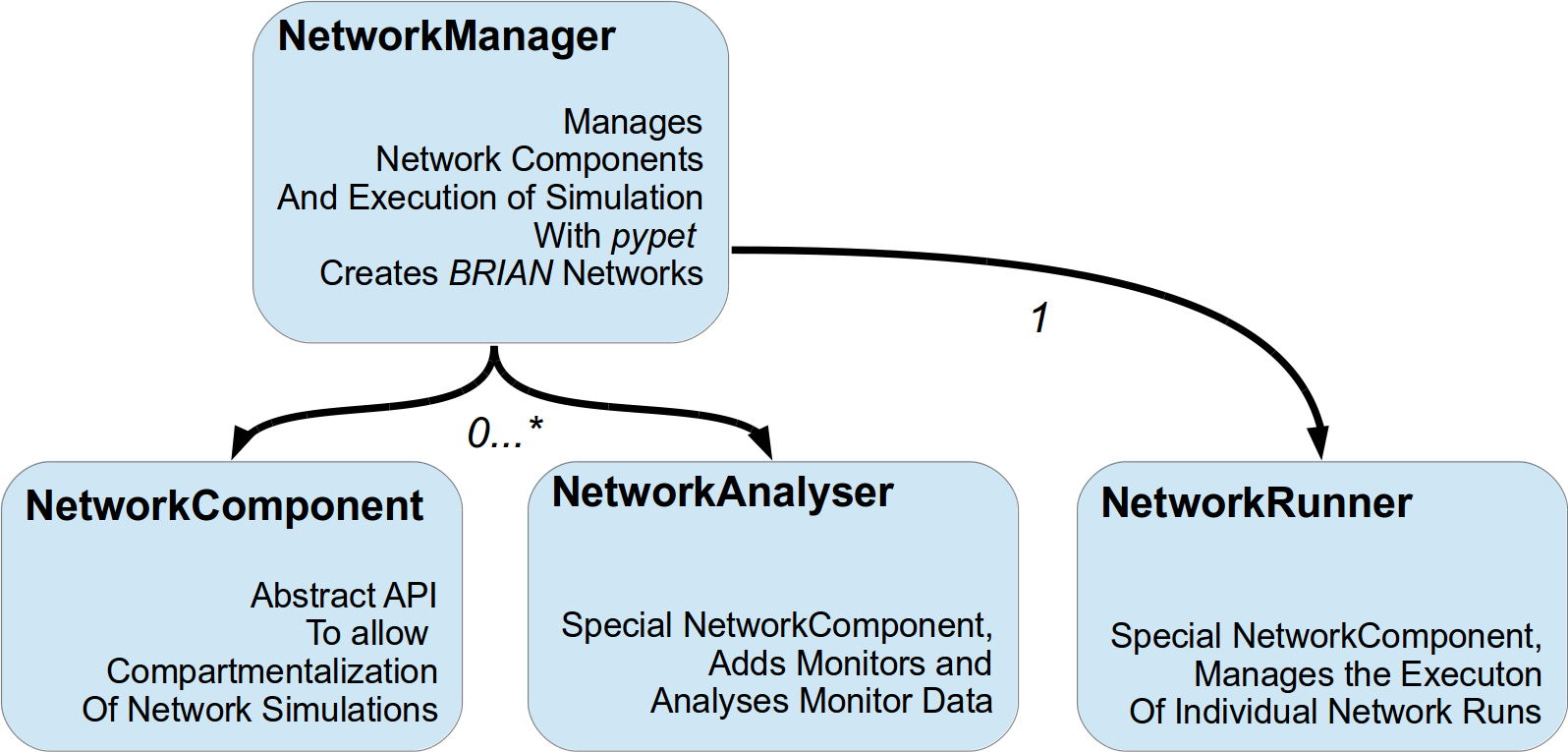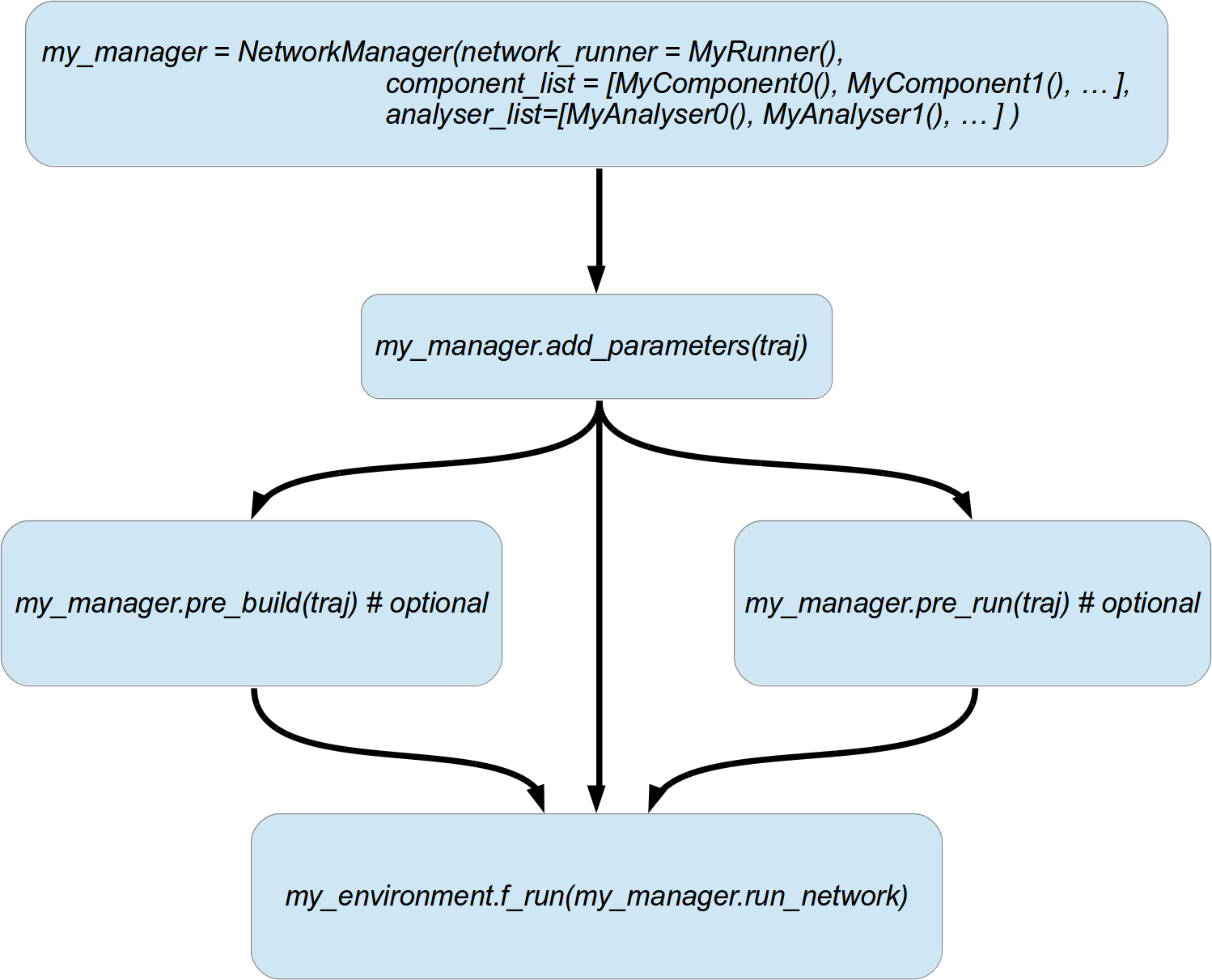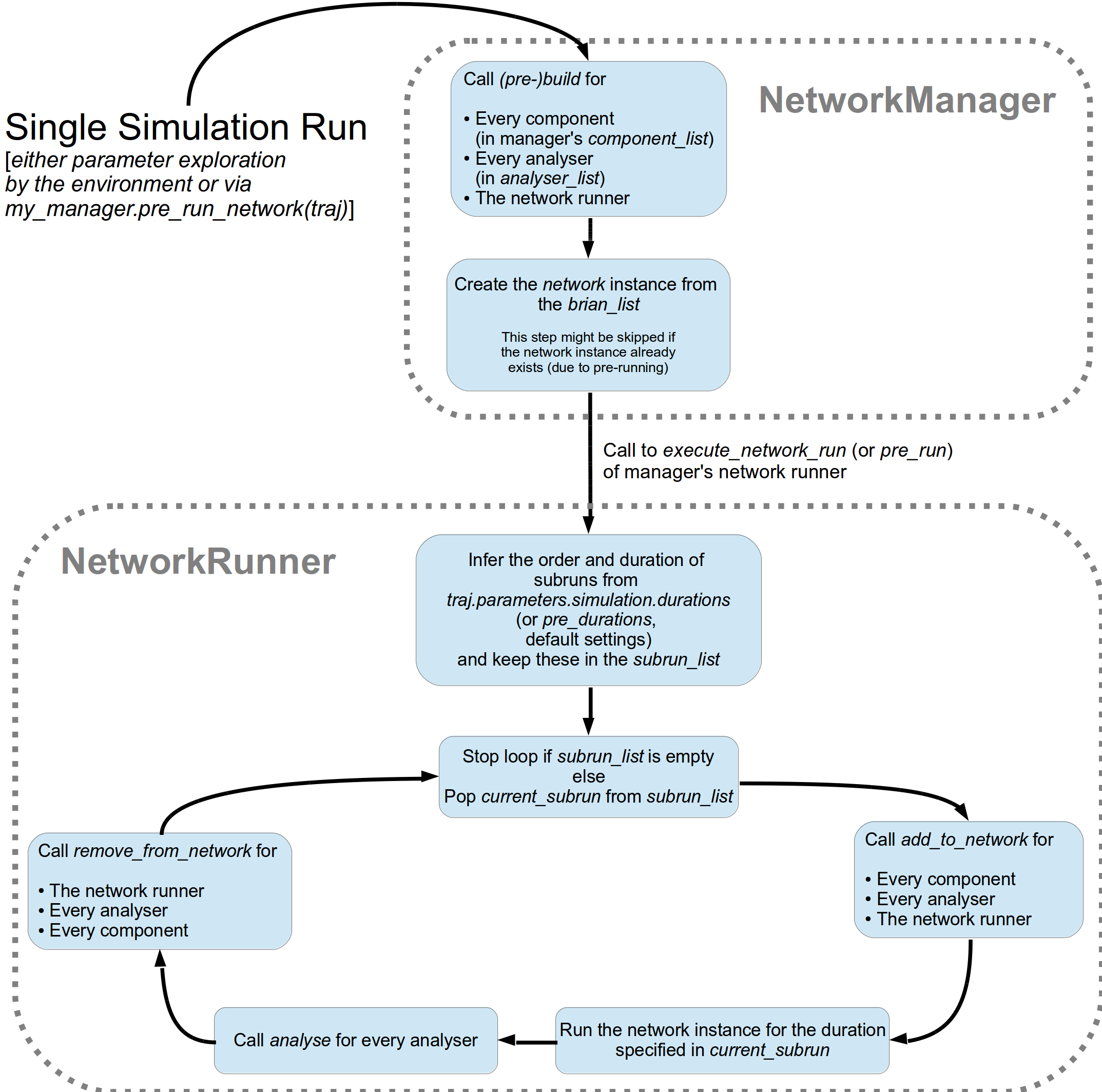Using BRIAN with pypet¶
IMPORTANT¶
Although the general pypet API is supposed to remain stable, this promise excludes the BRIAN part. The pypet BRIAN subpackage is still considered to be alpha. I probably won’t change too much within the pypet.brian.parameter module, but expect the pypet.brian.network module to undergo many changes and updates.
pypet and BRIAN¶
BRIAN as it comes is nice for small scripts and quick simulations, but it can be really hard to manage and maintain large scale projects based on very complicated networks with many parts and components. So I wrote a pypet extension that allows easier handling of more sophisticated BRIAN networks.
All of this can be found in pypet.brian sub-package. The package contains a parameter.py file that includes specialized containers for BRIAN data, like the BrianParameter, the BrianResult (both for BRIAN Quantities), and the BrianMonitorResult (extracts data from any kind of BRIAN Monitor).
These can be used in conjunction with the network management system in the network.py file within the pypet.brian package.
In the following I want to explain how to use the network.py framework to run large scale simulations. An example of such a large scale simulation can be found in 11 Large scale BRIAN simulation which is an implementation of the Litwin-Kumar and Doiron paper from 2012.
The BRIAN network framework¶
The core idea behind my framework is that simulated spiking neural network are not in one giant piece but compartmentalize. Networks consist of NeuronGroups, Connections or Synapses, Monitors and so on and so forth. Thus, it would be neat if these parts can be easily replaced or augmented without rewriting a whole simulation. You want to add STDP to your network? Just plug-in an STDP component. You do not want to record anymore from the inhibitory neurons? Just throw away a recording component.
To abstract this idea, the whole simulation framework evolves around the NetworkComponent class. This specifies an abstract API that any component (which you as a user implement) should agree on to make them easy to replace and communicate with each other.
There are two specialisation of this NetworkComponent API: The NetworkAnalyser and the NetworkRunner. Implementations of the former deal with the analysis of network output. This might range from simply adding and removing Monitors to evaluating the monitor data and computing statistics about the network activity. An instance of the latter is usually only created once and takes care about the running of a network simulation.
All these three types of components are managed by the NetworkManager that also creates BRIAN networks and passes these to the runner. Conceptually this is depicted in figure below.

Main Script¶
In your main script that you use to create an environment and start the parameter exploration, you also need to include these following steps.
- Create a NetworkRunner and your
NetworkComponent instances and NetworkAnalyser instances defining the layout and structure of your network and simulation.
What components are and how to implement these will be discussed in the next section.
Create a NetworkManager:
Pass your NetworkRunner (as first argument network_runner), all your NetworkComponent instances as a list (as second argument component_list) and all NetworkAnalyser instances (as third argument analyser_list) to the constructor of the manager.
Be aware that the order of components and analysers matter. The building of components, addition, removal, and analysis (for analyser) is executed in the order they are passed in the component_list and analyser_list, respectively. If a component B depends on A and C, make B appear after A and C in the list.
For instance, you have an excitatory neuron group, an inhibitory one, and a connection between the two. Accordingly, your NetworkComponent creating the connection must be listed after the components responsible for creating the neuron groups.
For now on let’s call the network manager instance my_manager.
Call my_manager.add_parameters(traj):
This automatically calls add_parameters(traj) for all components, all analysers and the runner. So that they can add all their necessary parameters to the the trajectory traj.
(Optionally) call my_manager.pre_build(traj):
This will automatically trigger the pre_build function of your components, analysers and the network runner.
This is useful if you have some components that do not change during parameter exploration, but which are costly to create and can be so in advance.
For example, you might have different neuron layers in your network and parts of the network do not change during the runtime of your simulation. For instance, your connections from an LGN neuron group to a V1 neuron group is fixed. Yet, the computation of the connection pattern is costly, so you can do this in pre_build to save some time instead of building these over and over again in every single run.
(Optionally) call my_manager.pre_run_network(traj)
This will trigger a pre run of the network. First my_manager.pre_build is called (so you do not have to call it yourself if you intend a pre run). Then a novel BRIAN network instance is created from the brian_list (see below). This network is simulated by your runner. The state after the pre run is preserved for all coming simulation runs during parameter exploration.
This is useful if your parameter exploration does not involve modifications of the network per se. For instance, you explore different input stimuli which are tested on the very same network. Moreover, you have the very same initialisation run for every stimulus experiment. Instead of re-simulating the init run over and over again for every stimulus, you can perform it once as a pre run and use the network after the pre run for every stimulus input.
Pass the run_network() to your environment’s f_run() to start parameter exploration. This will automatically initiate the build(traj) method for all your components, analysers and your runner in every single run. Subsequently, your network will be simulated with he help of your network runner.
These steps are also depicted in the figure below.

An example main script might look like the following:
env = Environment(trajectory='Clustered_Network',
filename='experiments/example_11/HDF5/',
log_folder='experiments/example_11/LOGS/',
continuable=False,
multiproc=True,
ncores=2,
use_pool=False)
#Get the trajectory container
traj = env.v_trajectory
# We create a Manager and pass all our components to the Manager.
# Note the order, MyNeuronGroupsComponent are scheduled before MyConnectionsComponent,
# and the Fano Factor computation depends on the MyMonitorAnalysisComponent
my_manager = NetworkManager(network_runner=MyNetworkRunner(),
component_list=(MyNeuronGroupsComponent(), MyConnectionsComponent()),
analyser_list=(MyMonitorAnalysisComponent(), MyFanoFactorComputingComponent()))
# Add parameters
my_manager.add_parameters(traj)
# Explore different values of a parameter
explore_list = np.arange(0.0, 42.0, 0.5).tolist()
traj.f_explore({'some.random.parameter.of.my.network' : explore_list})
# Pre-build network components
my_manager.pre_build(traj)
# Run the network simulation
env.f_run(my_manager.run_network)
Multiprocessing and Iterative Processing¶
The framework is especially designed to allow for multiprocessing and to distribute parameter exploration of network simulations onto several cpus. Even if parts of your network cannot be pickled, multiprocessing can be easily achieved by setting use_pool=False for your Environment.
Yet, single core processing is more subtle. In fact if you want to pre_build parts of your network or even pre run a whole network, you can no longer use iterative computation of the single runs of your parameter exploration. The reason for this lies in the deep inner parts of BRIAN. The problem is that BRIAN networks are not well encapsulated objects, but are strongly dependent on the whole BRIAN runtime environment. As a consequence, you cannot take snapshots of a network in order to rerun a given network. In case of parameter exploration, a BRIAN network changes after each single run. The starting condition of the second run are the network state after (!) the first run and not before the first run. The only solution to this problem is to not only copy the BRIAN network but also the whole BRIAN runtime environment. The straightforward way to do this is simply to fork a new process. This is the reason why you cannot run single core processing on pre-built networks.
If you want to come close to single core processing use multiproc=True and ncores=1 with your environment. If you really do not care about messed up initial conditions - maybe since you just debug your code - you can enforce true single core processing by passing force_single_core=True when you create your NetworkManager.
Next, I’ll go a bit more into detail about components and finally you will learn which steps are involved in a network simulation.
Network Components¶
Network components are the basic building blocks of a pypet BRIAN experiment. There exist three types:
- Ordinary NetworkComponent
- NetworkAnalyser for data analysis and recording
- NetworkRunner for simulation execution.
And these are written by YOU (eventually except for the network runner). The classes above are only abstract and define the API that can be implemented to make pypet‘s BRIAN framework do its job.
By subclassing these, you define components that build and create BRIAN objects. For example, you could have your own ExcNeuronGroupComponent that creates a NeuronGroup of excitatory neurons. Your ExcNeuronSynapsesComponent creates BRIAN Synapses to make recurrent connections within the excitatory neuron group. These brian objects (NeuronGroup and Synapses) are then taken by the network manager to construct a BRIAN network.
Every component can implement these 5 methods:
This function should only add parameters necessary for your component to your trajectory traj.
pre_build() and/or build()
Both are very similar and should trigger the construction of objects relevant to BRIAN like NeuronGroups or Connections. However, they differ in when they are executed. The former is initiated either by you directly (aka my_manger.pre_build(traj)), or by a pre run (my_manager.pre_run_network(traj)). The latter is called during your single runs for parameter exploration, before the BRIAN network is simulated by your runner.
The two methods provide the following arguments:
traj
Trajectory container, you can gather all parameters you need from here.
brian_list
A non-nested (!) list of objects relevant to BRIAN.
Your component has to add BRIAN objects to this list if these objects should be added to the BRIAN network at network creation. Your manager will create a BRIAN network via Network(*brian_list).
network_dict
Add any item to this dictionary that should be shared or accessed by all your components and which are not part of the trajectory container. It is recommended to also put all items from the brian_list into the dictionary for completeness.
For convenience I suggest documenting the implementation of build and pre-build and the other component methods in your subclass like the following. Use statements like Adds for items that are added to the list and dictionary and Expects for what is needed to be part of the network_dict in order to build the current component.
For instance:
brian_list:
Adds:
4 Connections, between all types of neurons (e->e, e->i, i->e, i->i)
network_dict:
Expects:
‘neurons_i’: Inhibitory neuron group
‘neurons_e’: Excitatory neuron group
Adds:
- ‘connections’ : List of 4 Connections,
between all types of neurons (e->e, e->i, i->e, i->i)
This method is called shortly before a subrun of your simulation (see below).
Maybe you did not want to add a BRIAN object directly to the network on its creation, but sometime later. Here you have the chance to do that.
For instance, you have a SpikeMonitor that should not record the initial first subrun but the second one. Accordingly, you did not pass it to the brian_list in pre_build() or build(). You can now add your monitor to the network via its add functionality, see the the BRIAN network class.
The add_to_network() relies on the following arguments
traj
Trajectoy container
network
BRIAN network created by your manager. Elements can be added via add(...).
current_subrun
BrianParameter specifying the very next subrun to be simulated. See next section for subruns.
subrun_list
List of BrianParameter objects that are to be simulated after the current subrun.
network_dict
Dictionary of items shared by all components.
This method is analogous to add_to_network(). It is called after a subrun (and after analysis, see below), and gives you the chance to remove items from a network.
For instance, you might want to remove a particular BRIAN Monitor to skip recording of coming subruns.
Be aware that these functions can be implemented, but they do not have to be. If your custom component misses one of these, there is no error thrown. Instead, simply pass is executed (see the source code!).
NetworkAnalyser¶
The NetworkAnalyser is a subclass of an ordinary component. It augments the component API by the function analyse(). The very same parameters as for add_to_network() are passed to the analyse function. As the name suggests, you can run some analysis here. This might involve extracting data from monitors or computing statistics like Fano Factors, etc.
NetworkRunner¶
The NetworkRunner is another subclass of an ordinary component. The given NetworkRunner does not define an API but provides functionality to execute a network experiment. There’s no need for creating your own subclass. Yet, I still suggest subclassing the NetworkRunner, but just implement the add_parameters() method. There you can add BrianParameter instances to your trajectory to define how long a network simulation lasts and in how many subruns it is divided.
A Simulation Run and Subruns¶
A single run of a network simulation is further subdivided into so called subruns. This holds for a pre run triggered by my_manager.pre_run_network(traj) as well as an actual single run during parameter exploration.
The subdivision of a single run into further subruns is necessary to allow having different phases of a simulation. For instance, you might want to run your network for an initial phase (subrun) of 500 milliseconds. Then one of your analyser components checks for pathological activity like too high firing rates. If this activity is detected, you cancel all further subruns and skip the rest of the single run. You can do this by simply removing all subruns from the subrun_list. You could also add further BrianParameter instances to the list to make your simulations last longer.
The subrun_list (as it is passed to add_to_network(), remove_from_network(), or analyse()) is populated by your network runner at the beginning of every single run (or pre-run) in your parameter exploration. The network runner searches for BrianParameter instances in a specific group in your trajectory. By default this group is traj.parameters.simulation.durations (or traj.parameters.simulation.pre_durations for a pre-run), but you can pick another group name when you create a NetworkRunner instance. The order of the subruns is inferred from the v_annotations.order attribute of the BrianParameter instances. The subruns are executed in increasing order. The orders do not need to be consecutive, but a RuntimeError is thrown in case two subruns have the same order. There is also an Error raised if there exists a parameter where order cannot be found in it’s v_annotations property.
In previous versions of pypet.brian there was a so called BrianDurationParameter that possessed a special attribute v_order. This was basically a normal BrianParameter with a little bit of overhead. Thus, the BrianDurationParameter became a victim of refactoring. There is still an implementation left for backwards-compatibility. Please, do NOT use the old BrianDurationParameter, but a normal BrianParameter and replace calls to v_order with v_annotations.order.
For instance, in traj.parameter.simulation.durations there are three BrianParameter instances.
>>> init_run = traj.parameter.simulation.durations.f_add_parameter('init_run', 500 * ms)
>>> init_run.v_annotations.order=0
>>> third_run = traj.parameter.simulation.durations.f_add_parameter('third_run', 1.25 * second)
>>> third_run.v_annotations.order=42
>>> measurement_run = traj.parameter.simulation.durations.f_add_parameter('measurement_run', 15 * second)
>>> measurement_run.v_annotations.order=1
One is called init_run, has v_annotations.order=0 and lasts 500 milliseconds (this is not cpu runtime but BRIAN simulation time). Another one is called third_run lasts 1.25 seconds and has order 42. The third one is named measurement_run lasts 5 seconds and has order 1. Thus, a single run involves three subruns. They are executed in the order: init_run involving running the network for 0.5 seconds, measurement_run for 5 seconds, and finally third_run for 1.25 seconds, because 0 < 1 < 42.
The current_subrun BrianParameter is taken from the subrun_list. In every subrun the NetworkRunner will call
- for all ordinary components
- for all analysers
- for the network runner itself
run(duration) from the BRIAN network created by the manager.
Where the duration is simply the data handled by the current_subrun which is a BrianParameter.
analyse() for all analysers
- for the network runner itself
- for all analysers
- for all ordinary components
The workflow of network simulation run is also depicted in the figure below.

I recommend taking a look at the source code in the pypet.brian.network python file for a better understanding how the pypet BRIAN framework can be used. Especially, check the _execute_network_run() method that performs the steps mentioned above.
Finally, despite the risk to repeat myself too much, there is an example on how to use pypet with BRIAN based on the paper by Litwin-Kumar and Doiron paper from 2012, see 11 Large scale BRIAN simulation.
Cheers,
Robert